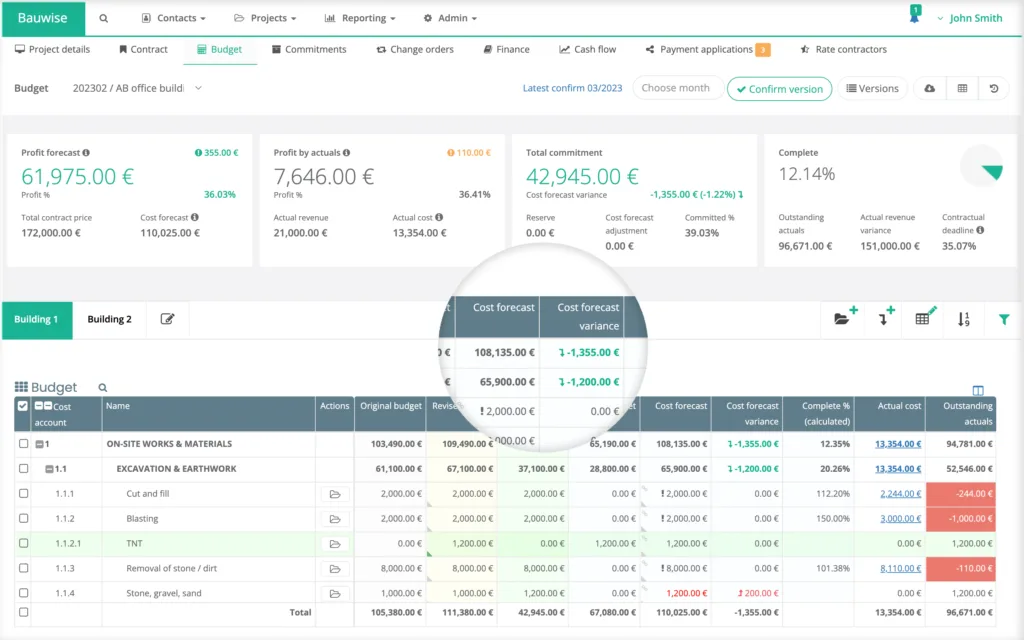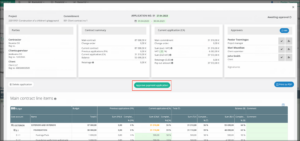Construction project forecasting is crucial for controlling cash flow, doing risk assessments, setting achievable goals, and forming accurate budgets. They guide important decisions that enable construction companies to succeed and remain competitive. However, creating these forecasts can be a complex task for project managers, CFOs, or financial controllers.
Construction finance teams face significant pressure to enhance their company’s performance and reduce costs. Often, they encounter challenges with processes and technologies that aren’t well integrated or don’t provide easy access to data.
Adopting appropriate technologies and adhering to best practices can address many of these challenges.
Table of Contents
What is forecasting in construction?
Forecasting project costs involves analyzing data and previous project experiences to predict the costs and results of future construvtion projects, whether remodeling or entirely new constructions. This systematic approach helps in planning by providing a clearer picture of expected costs and potential challenges. It not only aids in setting realistic objectives for everyone involved but also equips the team to manage finances better and minimize risks. Key aspects of effective construction cost forecasting include monitoring market trends, anticipating material shortages, preparing for labor scarcities, and adjusting for economic fluctuations. This strategic insight ensures that decisions are based on solid historical data rather than guesswork, enhancing the project’s chances for success.
What are the different types of construction forecasts?
In construction, forecasting methods include cash flow, materials, and job costing. Predicting these elements using past data helps you plan and budget effectively for future construction projects.
Cash Flow Forecasts
Cash flow forecasting in construction means predicting the money that will flow in and out during a project or over a certain period. The aim is to ensure that your cash flow is either positive or balanced, meaning you’re not in debt. Start by ensuring all invoices related to upcoming project costs are current. Then, calculate your costs for subcontractors and materials and subtract these from your total project estimate to see your potential profit.
Forecasting improves with experience, as comparing past estimates to actual expenses can help refine future forecasts and improve accuracy. Utilizing construction management software with financial tools can significantly enhance the accuracy of your cash flow forecasts.
Material Forecasts
Forecasting materials involves estimating the quantities and costs of materials needed for your projects. Having enough materials is crucial, but only a little, mainly when supplies are limited. Stay informed about construction industry trends to anticipate material costs and availability. Construction takeoff software can save time and provide a detailed list of materials and costs for each project, which can be referenced in the future.
Job Costing
Forecasting job costs involves tracking the total labor, materials, and overhead expenses. This is vital for unique or large projects, where detailed expense tracking helps assess the overall project budget. By predicting project costs, you can determine the profitability of each job and decide which projects are worth pursuing. Job costing requires meticulous record-keeping of every item, hour worked, and overhead cost.
Planning thoroughly for all aspects of a construction project can lead to increased profits. Learning to use the forecasting features of advanced construction software, such as Bauwise, can enhance your forecasting accuracy and financial outcomes.
How do you forecast construction costs?
When trying to come up with the most accurate cost forecasts for a construction project, there are several vital factors you should consider:
Historical Data
Before your project starts, look back at similar projects your company has handled. Ask yourself:
- What were the past labor, materials, and transportation costs?
- What internal changes (like new processes or employees) have occurred since then?
- What external factors (like economic downturns or material shortages) could affect the industry now?
- Comparing these past insights with your current situation helps you estimate potential expenses and form a strong forecasting foundation. You might also use software to help analyze this historical data and manage construction accounting.
Project Scope
Understanding the full scope of your project is crucial. Focusing only on major tasks is easy, but the smaller details can significantly affect the project’s duration and cost. A technique like the Work Breakdown Structure (WBS) can be beneficial here. WBS breaks the project into smaller parts or deliverables, each with defined costs, scope, and deadlines, helping you organize and manage tasks effectively within the planned budget and time frame.
Project Duration
The length of the project is closely tied to its scope. A construction project consists of interconnected tasks that need to happen in a specific sequence. Consider the order of operations and the expected delivery dates. Use past project data to gauge how long similar tasks have taken and allow some flexibility to accommodate delays. Engage your team in setting realistic deadlines and track project progress meticulously to refine future forecasts.
Labor Costs
Labor can make up 20% to 40% of the total project cost and is one of the hardest expenses to predict. Factors to consider include:
- Changing productivity levels over time
- Different skills needed at different project stages
- Costs beyond wages (like holiday pay and sick leave)
- Variable labor demands as the project progresses
- Instead of just counting hours, break down the project into tasks that require specific skills. Assign the right people to these tasks and estimate their hours to predict labor costs better.
By considering these factors, you can create more reliable and detailed cost forecasts for your construction projects.
What are the three biggest challenges in cost forecasting?
Cost forecasting in construction is a crucial process for budgeting and financial planning of future projects, but it faces several significant challenges. The three biggest challenges in cost forecasting that impact the accuracy and reliability of these estimates include material costs, inflation, and supply disruptions. Here’s a detailed look at each of these challenges:
Material Costs
- Variability: These costs can vary significantly over time and between regions. This variability is influenced by factors such as demand and supply dynamics, geopolitical issues, and changes in production costs. For instance, the cost of lumber might skyrocket due to a sudden increase in housing projects or could fall due to overproduction.
- Forecast Accuracy: Accurately predicting material costs requires detailed market analysis and the ability to anticipate changes. Mistakes in forecasting these costs can lead to significant budget overruns or underfunding, affecting the entire project’s financial health.
Inflation
- Economic Impact: Inflation affects overall financial stability and purchasing power, which in turn influences construction costs. As the general price level of goods and services rises, so do construction materials and labor costs.
- Long-term Projects: For projects spanning several years, inflation can be particularly challenging to forecast. A slight miscalculation in the expected inflation rate can result in substantial differences between projected and actual costs, making it difficult to maintain budget control.
Supply Disruptions
- Unpredictability: Supply chain disruptions can be caused by unforeseen events such as natural disasters, strikes, or pandemics. These disruptions can halt the supply of critical materials, leading to project delays and increased costs due to the need for rapid sourcing alternatives.
- Dependency on Global Markets: Many projects depend on materials sourced from across the globe. Any instability in international markets, such as tariffs, trade wars, or political unrest, can disrupt supply chains and inflate costs unexpectedly.
Compliance
Project forecasting is more than just educated guesses—it involves precise calculation and consideration. However, it’s also prone to errors, leading to forecasts that don’t align with actual outcomes. Several factors can influence this discrepancy:
- The skills and perspectives of the individual making the forecast
- The accuracy of Work Breakdown Structures (WBS) or financial reports
- The consistency of reporting standards within your organization
- Techniques used for managing cash flow
- The expectations and requirements set by your clients
As a project manager, handling these variables effectively is crucial to ensure your forecasts are reliable and realistic.
Stakeholder Management
A construction project thrives on effective collaboration, which includes ongoing interactions with your team, subcontractors, and suppliers. However, these interactions can also pose significant challenges to accurate cash flow forecasting due to:
- Delayed information from suppliers
- Incomplete or incorrect cooperation terms from contractors
- Slow or nonexistent communication channels
Despite these hurdles, your responsibility remains to manage these relationships and maintain precise forecasts amid this information disorder.
Fast and Unpredictable Changes
The construction sector is notably volatile. Events like global pandemics, disruptions in supply chains, government regulations, and economic fluctuations such as inflation were hardly predictable a few years ago yet have profound impacts on projects:
- Changes in client expectations and project scope
- External influences such as weather conditions and fluctuating oil and gas prices
- Variability in contractor terms and raw material costs
- Economic shifts, including inflation, government policies, and currency valuation changes
Since many construction projects extend over a year, many changes can occur within this period, making it challenging to determine the financial needs accurately. This unpredictability of future costs is a common hurdle for forecasters, often leading to budget overruns.
5 Tips for Accurate Construction Forecasting
Implement these five tips for better cost forecasting.
1. Automate processes
Automating processes in construction forecasting is a game-changer that can significantly improve efficiency and accuracy. By using financial automation tools, you can eliminate the need for manual data collection, which is often time-consuming and prone to errors. These tools automatically gather and integrate data across various systems, ensuring that all departments have access to consistent and up-to-date information.
This automation saves valuable time and enhances the scope and accuracy of your forecasts. You can generate reports quickly, track changes, update task priorities, and review contract details with just a few clicks rather than spending hours on manual work. Additionally, automating invoicing and payment processes ensures precise cash flow management, providing real-time insights into the financial health of your projects. It eliminates the need for repetitive communication and double entries, keeping budgets updated as change orders are approved.
In a competitive market, failing to adopt automation may lead to losing clients to rivals who utilize these advanced tools. Therefore, embracing automation in forecasting processes boosts productivity and gives your business a strategic advantage.
2. Create a collaborative workflow
Implementing effective workflows is crucial for achieving accurate data and efficient forecasting in the construction process. A well-designed workflow assigns clear responsibilities to each team member, ensuring everyone knows their specific tasks and deadlines. This clarity helps prevent data from getting trapped in silos within different departments or files, which can be a significant hurdle in creating accurate forecasts.
To streamline the forecasting process, it’s essential to establish a sequence of steps everyone follows. This organizes how data is collected, and reports are generated and ensure that all necessary information is accounted for promptly. Whether you use a specialized construction system like Bauwise or more traditional methods, the key is to maintain a structured approach that includes all stakeholders. This collaborative effort helps make construction project forecasting much faster, more efficient, and less prone to errors.
By building and maintaining these workflows, your team can quickly address issues like material delays or change orders, reducing delays and enhancing accountability. Overall, well-implemented workflows make your project management and financial forecasting more reliable, leading to better outcomes for your projects.
3. Create collaborative environment
Creating a collaborative environment is essential for accurate forecasting in construction projects. The success of your forecasts heavily depends on the contributions and insights from your contractors, suppliers project managers, and employees. These individuals often have the most detailed knowledge about the time, money, and effort required for each task and are usually the first to notice when changes occur that might affect the forecast.
To enhance the accuracy of your forecasts, it’s important to involve all relevant parties in the construction project forecasting process. This isn’t just a task for finance professionals; it’s a team effort that benefits from diverse perspectives. Poor project data and inadequate communication can lead to significant rework in construction projects, highlighting the need for effective collaboration across departments.
By encouraging continuous communication and improvement, you ensure everyone is on the same page and can quickly adapt to changes. This collaborative approach not only reduces the likelihood of errors but also promotes accountability among team members. Moreover, when departments understand how their performance impacts the overall business, they are more likely to provide accurate data and make informed decisions. This team-oriented atmosphere leads to more reliable forecasts and, ultimately, better project outcomes.
4. Use technology to forecast construction costs
Using technology for cost forecasting in construction offers significant benefits over traditional methods like paper or Excel. Traditional tools pose a higher risk of errors due to manual calculations and have several limitations:
- It takes a lot of work to update your forecasts regularly.
- You can’t effectively analyze the project’s ongoing progress.
- Developing customizable forecasting methods is not feasible.
- Real-time collaboration on documents with your team is impossible.
- Finding specific information within complex calculations takes more time.
Thankfully, modern solutions are available to alleviate these issues. Software like Bauwise and other financial automation platforms enable more efficient and accurate forecasting. These tools utilize data from past projects to provide smart trend analysis and predictive cost insights. This capability transforms large volumes of data into clear, actionable business insights, significantly enhancing the forecasting process.
By adopting such technologies, you can:
- Instantly update and adjust forecasts as new data becomes available.
- Collaborate seamlessly with your team in real-time.
- Customize methods to suit specific project needs.
- Access specific information quickly and easily.
Ultimately, leveraging technology in construction project forecasting not only reduces the likelihood of errors but also adds a layer of flexibility and precision that traditional methods lack. This technological approach ensures that your business can adapt to changes swiftly and maintain accuracy in financial planning and project management.
5. Make sure to continue re-forecasting
Continuously updating your forecasts or re-forecasting is crucial for maintaining accuracy throughout the lifecycle of a construction project. The re-forecasting process helps you adapt to rapid and unforeseen changes impacting your project’s budget and timeline. Here are some key benefits of never stopping your re-forecasting efforts:
- Better Project Control: Regular updates to your forecasts give you better control over the project, allowing you to manage resources and schedules more effectively.
- Informed Decisions: Up-to-date information helps you make more informed decisions, steering the project in the right direction.
- Reduced Mistakes: Continuous re-forecasting helps you learn from past errors, reducing the likelihood of repeating them.
- Improved Forecasting Methods: Over time, you’ll develop more effective forecasting methods based on accumulated experience.
Your forecast should not be a one-time document created at the project’s outset and ignored. Such an approach can render the forecast obsolete as conditions change, making it a useless tool that doesn’t reflect the project’s current status or needs.
Instead, adopting a rolling forecast approach allows you to adjust your projections regularly based on current project performance, changing costs, and material availability. This not only keeps your budget and schedule aligned with reality but also enhances your overall business insight. By continuously adjusting your forecasts, you can prevent financial discrepancies and gain a clearer understanding of where your project—and your company—stands financially at any given time.
Use Bauwise Construction Forecasting Software
Start using construction forecasting software, which helps you to forecast your construction project costs so you don’t have any unexpected budget surprises.
FAQ
What is cash flow forecasting in construction?
Cash flow forecasting in construction involves predicting the amount of money flowing in and out of a construction project over a specific period. This helps manage the project’s finances by planning when money will be needed for expenses like materials, labor, and equipment and when it will be received from payments, ensuring there are always enough funds available to keep the project running smoothly.
How do you forecast a construction budget?
To forecast a construction budget, you review all your information about the project and use it to estimate the costs. It’s also crucial to research previous projects and current market trends and prices to make your forecast more accurate.
What are the different construction forecasting methods?
The main methods for forecasting costs include cash flow, materials, and job costing. Using all three methods together helps to predict costs and ensure the most accurate prediction of construction expenses.
Why is forecasting important in construction?
Forecasting is crucial in the construction business because it helps you plan ahead for project costs and make informed business decisions using accurate data. Your business’s success depends on understanding economic changes, market trends, potential delays in getting materials, and labor shortages. Having the correct information gives you a significant advantage in the constructio
What are the benefits of construction forecasting?
Construction forecasting offers several advantages:
-It increases the likelihood of completing a project on budget and on time.
-It enhances teamwork across different departments within the company.
-It provides a deeper understanding of your business operations.
-It serves as a guide for future financial planning.
-It improves the accuracy of setting deadlines and making strategic project decisions.
-It establishes a foundation for effective cash flow management.
About the Author

Taavi Kaiv
Taavi Kaiv is a construction specialist with over ten years of experience in the construction industry. Taavi is an accomplished construction project manager with many successful projects that have been completed under his guidance. Taavi holds a master’s degree in construction management from the Tallinn University of Technology. View profile





